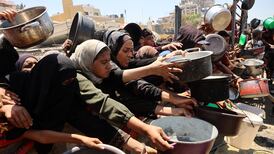During its two-month offensive against Hamas in Gaza, Israel’s air strikes have not only killed thousands of Palestinians and levelled their homes – they have also targeted their ancient and medieval cultural heritage.
“If this heritage be no more in Gaza, it will be a big loss of the identity of the people in Gaza,” Catalonia-based Heritage for Peace president Isber Sabrine told the US news site NPR. “The people in Gaza, they have the right to keep and to save this heritage, to tell the history, the importance of this land,” he said.
Gaza is a crucible of cultures fused by war, trade and human interaction. A land bridge between Egypt and the Levant, it was a commercial and agricultural centre during Egyptian, Philistine, Babylonian, Greek, Roman, Byzantine, Arab and Ottoman rule. Alexander the Great captured Gaza’s fortress in 322 BC before marching his army southwards into Egypt. Napoleon’s forces marched north from Egypt and seized Gaza’s ancient port from the Ottomans in 1799 en route to Jaffa.
Many globally significant archaeological sites of the 195 identified by field surveys in Gaza remain to be excavated. After one month of Israel’s bombardment, Heritage for Peace listed 104 sites that were damaged or destroyed. These included mosques, churches, museums and archaeological sites.
READ MORE
In Jabaliya in the north of Gaza, the 7th-century Omari mosque and its library containing historical manuscripts were obliterated and Gaza City’s St Porphyrius church, believed to be the third oldest church in the world, was attacked as hundreds of Palestinians sheltered inside. The excavated Deir al-Balah cemetery dating to 1550-1200 BC was devastated. The Pasha Palace museum where Napoleon stayed in Gaza City was partially damaged.
Although experts have little information on the current condition of sites due to the war, the London- and New York-based Art Newspaper website quoted Palestinian antiquities ministry spokesman Jihad Yasin as saying that at the end of November, a 2,000-year old Roman cemetery was “almost completely destroyed”. He said museums in Rafah, Deir al-Balah and Khan Younis were targeted. Anthedon Harbour, a Unesco World Heritage site, Gaza’s first known seaport (800 BC to 1100 AD) has been damaged.
Expressing concern over the “adverse impact of the ongoing fighting on cultural heritage”, a Unesco spokesperson said in a statement sent to NPR: “Our organisation calls on all parties involved to strictly adhere to international law. Cultural property should not be targeted or used for military purposes, as it is considered to be civilian infrastructure.”
Contemporary civilian infrastructure has also been bombed. The Central Archives containing documents spanning 150 years of Gaza’s history have been destroyed. Gaza City’s main library and the Rashad Shawwa cultural centre and its library were gutted. The Islamic University, Al-Azhar University and the north Gaza branch of Al-Quds Open University have been damaged. The United Nations Palestinian refugee relief agency (UNRWA) has reported its 156 schools, hosting 1.2 million displaced Palestinians, have been attacked more than 120 times.
- Sign up for push alerts and have the best news, analysis and comment delivered directly to your phone
- Find The Irish Times on WhatsApp and stay up to date
- Our In The News podcast is now published daily – Find the latest episode here















